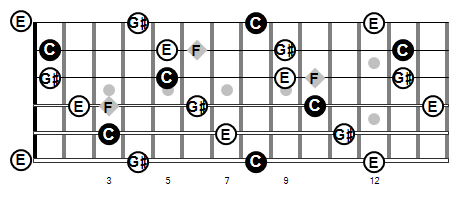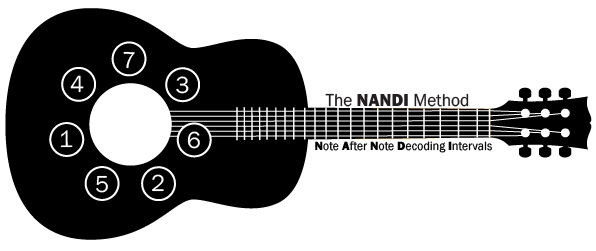Augmented Triads
Unlike the major and minor triads, which include both major and minor thirds, the augmented triad has two major thirds stacked from the root. This makes augmented triads symmetrical, meaning the distance from the 1 to 3, and 3 to 5 is the same (the other symmetrical triad is the diminished triad). In the case of the augmented triad, there is a major third between 1 and 3, 3 and #5, #5 and 1. This makes the chord formula (R 3 #5).
As an example, let’s take the C+ triad. The notes of the chord are C – E – G#. As we can see, each note is a major third apart (Root + Major Third + Major Third). An augmented C triad can be indicated in two ways: C+ or Caug.
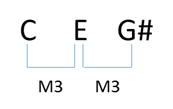
If we invert this chord, the first inversion reads E – G# – C. Once again, these notes are a major third apart from each other.

This chord is both a C+ in first inversion and E+ in root position.
E+ in first inversion is G# – C – E. Notice there is still a major third interval between the notes.
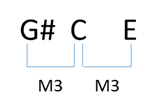
We see this chord as C+ in second inversion, E+ in first inversion, and G#+ in root position.
Let’s repeat the process to go back to the first chord. If we invert the last chord, we come back to C – E – G#.

Now we are back at C+, our starting point. However, this is also G#+ in first inversion and E+ in second inversion.
In summary we can observe the following:
C+ Root = G#+ 1st = E+ 2nd
E+ Root = C+ 1st = G#+ 2nd
G#+ Root = C+ 2nd = E+ 1st
Moving one step further, we can say that C+, E+ and G#+ are the same chord, meaning there are only four augmented chords in the entire 12 semitone system:
C+, C#+, D+ and D#+
All of the other chords in the system are simply inversions of these three.
How does this apply on the guitar?

Every four frets (M3 or four semitones), the chord repeats itself using the same shape and the root position, as well as its inversions, have the same shape as well.
Below you will find the intervals of a C augmented triad (C-E-G#) in root, 1st and 2nd inversions (frets 5-8) on the fretboard.

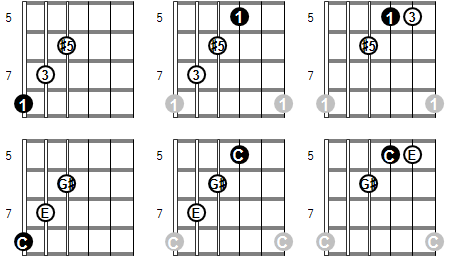
Take a look at the notes of the Caug triad (C-E-G#) in the fretboard below. A perfect fourth from root C which is F (indicated in the grey diamonds) can be used as a reference point to locate the chord tone E one fret below.
